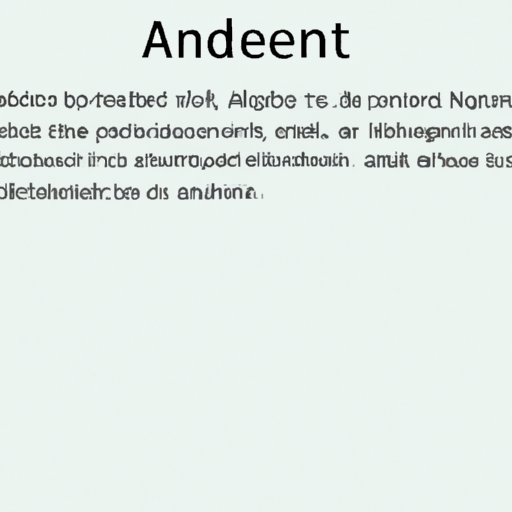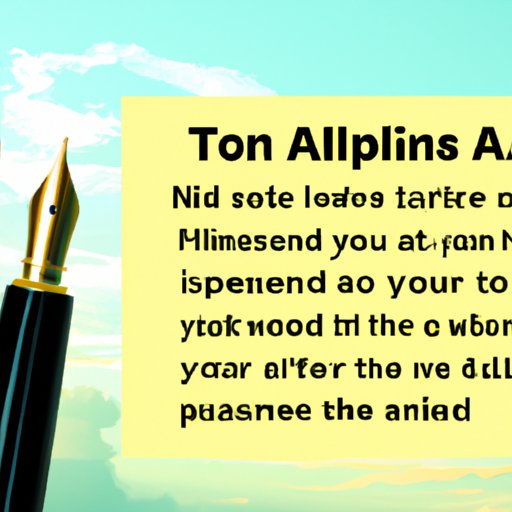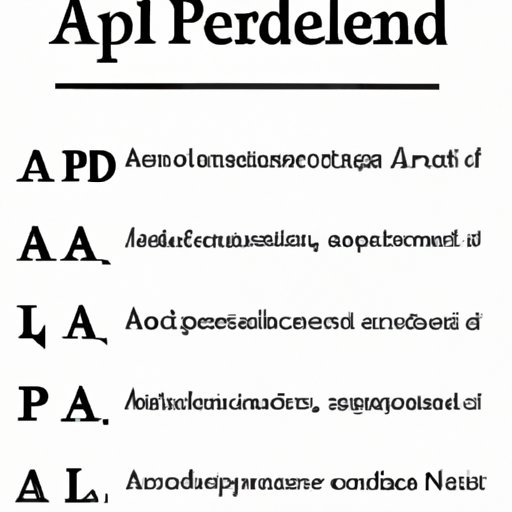
An Overview of the Appendix in Writing
An appendix is a section at the end of a document or book that includes additional information for the reader. It can be used to provide supplemental material that may not be essential to the main text, but still provides useful information. The appendix can also be used to provide evidence or support for the claims made in the text.
Definition of an Appendix
An appendix is an optional part of a document or book that is used to add additional information for the reader. It is typically located at the end of the document or book and contains information that may not be essential to the main text, but still provides useful information. The appendix can also be used to provide evidence or support for the claims made in the text.
Types of Materials That Can Be Included in an Appendix
The type of material included in an appendix depends on the purpose of the document or book. Common materials that are included in an appendix include: tables, diagrams, images, maps, charts, graphs, raw data, questionnaires, sample documents, detailed descriptions of research methods, and references.
How to Use an Appendix Effectively in Writing
When using an appendix in writing, it is important to consider why you are including it and how it will fit into the overall structure of the document. Here are some tips for using an appendix effectively:
Reasons to Include an Appendix
Appendices can be used for a variety of reasons, such as providing additional evidence to support your claims, providing additional information that may be too lengthy or complex to include in the main body of the document, or providing readers with additional resources. Consider why you are including an appendix and make sure it serves a purpose.
Tips for Formatting and Organizing Appendices
When formatting an appendix, make sure to use the same font and font size as the main body of the document. Additionally, create a separate title page for each appendix, clearly label each appendix with a letter or number, and add a table of contents so that readers can easily navigate between appendices. Lastly, make sure to list all appendices in the table of contents.
The Benefits and Pitfalls of Including an Appendix in Your Document
Including an appendix in your document can be beneficial in certain circumstances. However, there are potential pitfalls that should be considered before including an appendix in your document.
Benefits of Including an Appendix
One of the main benefits of including an appendix in your document is that it allows you to provide readers with additional resources and information that may not be essential to the main text, but still provides useful information. Additionally, an appendix can provide evidence or support for the claims made in the text. Finally, an appendix can help to make the document more organized and easier to navigate.
Potential Pitfalls of Including an Appendix
One potential pitfall of including an appendix is that it can make the document longer and more difficult to read. Additionally, if the appendix does not contain relevant information or is not properly formatted and organized, it can detract from the overall quality of the document. Therefore, it is important to carefully consider why you are including an appendix and make sure it is necessary and relevant.

Common Examples of Appendices in Documents
Appendices can be found in a variety of different types of documents, including academic, business, and legal documents. Here are some common examples of appendices in documents:
Academic Documents
In academic documents, appendices can be used to include additional information that may be too lengthy or complex to include in the main body of the document. This could include tables, diagrams, images, maps, charts, graphs, raw data, questionnaires, sample documents, and detailed descriptions of research methods.
Business Documents
In business documents, appendices can be used to include additional information that is relevant to the main body of the document. This could include financial statements, contracts, marketing plans, customer surveys, and product specifications.
Legal Documents
In legal documents, appendices can be used to include additional information that is relevant to the main body of the document. This could include court orders, affidavits, witness statements, and case law.

Tips for Crafting an Effective Appendix in Your Writing
When crafting an effective appendix in your writing, it is important to keep the following tips in mind:
Choose Relevant Materials to Include
When choosing materials to include in an appendix, make sure they are relevant to the main text and serve a purpose. Avoid including unnecessary or irrelevant information.
Keep the Length of the Appendix Brief
Keep the length of the appendix brief by only including essential information. If the appendix is too long, it can detract from the overall quality of the document.
Follow the Accepted Formatting Guidelines
Make sure to follow the accepted formatting guidelines when creating an appendix. This includes using the same font and font size as the main body of the document, creating a separate title page for each appendix, and adding a table of contents.
Include a Table of Contents
Including a table of contents in the appendix can make it easier for readers to navigate between different parts of the appendix. Make sure to list all appendices in the table of contents.
Make Sure the Appendix Is Easy to Navigate
Make sure the appendix is easy to navigate by clearly labeling each appendix with a letter or number and making sure the formatting is consistent throughout. This will help to ensure that readers can quickly and easily find the information they need.
Conclusion
An appendix can be a useful tool for providing readers with additional information and resources. However, it is important to consider why you are including an appendix and make sure it serves a purpose. When crafting an effective appendix in your writing, make sure to choose relevant materials to include, keep the length of the appendix brief, follow the accepted formatting guidelines, include a table of contents, and make sure the appendix is easy to navigate.
(Note: Is this article not meeting your expectations? Do you have knowledge or insights to share? Unlock new opportunities and expand your reach by joining our authors team. Click Registration to join us and share your expertise with our readers.)
